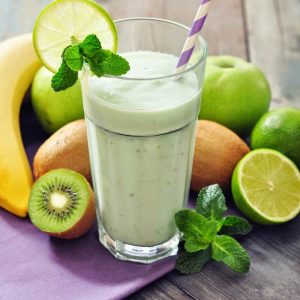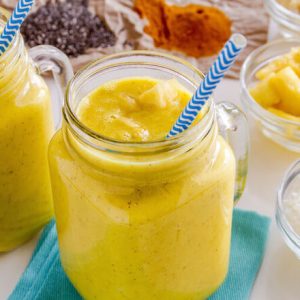We’ve been fed since the early 1950’s that we need sunscreen to prevent us from getting skin cancer. While there is some truth to these statements, the conventional sunscreen you find on the market definitely isn’t protecting anyone from skin cancer. In fact, sunscreen ingredients could be causing skin cancer itself (ever wonder where there’s been a rise in skin cancer cases since sunscreen hit the market?).
Chemical-free sunscreen isn’t difficult to make, and given that conventional sunscreen is full of harmful chemicals and toxins, it’s almost essential that you do all that you can to steer clear of it.
Does Conventional Sunscreen Cause Cancer?
While many people aren’t crazy about the idea that conventional sunscreen increases the chances of getting skin cancer, the studies are telling us just that.
In the years since sunscreen use began, skin cancer rates have actually risen, and a 2007 document from the FDA stated that: “The FDA is not aware of data demonstrating that sunscreen use alone helps prevent skin cancer (1).”
Up to 30% of the sunscreens on the market contain a form of vitamin A (retinyl palmitate) that may actually speed the development of skin tumours and lesions (2). Furthermore, the FDA has known about the dangers of vitamin A in sunscreens since they ordered a study over 10 years ago – yet the public hasn’t been alerted.
“Retinyl palmitate was selected by (FDA’s) Center for Food Safety and Applied Nutrition for photo-toxicity and photocarcinogenicity testing based on the increasingly widespread use of this compound in cosmetic retail products for use on sun-exposed skin,” said an October 2000 report by the National Toxicology Program.
Other problems with sunscreens include:
– Use of the hormone-disrupting chemical, oxybenzone, which penetrates the skin and enters the bloodstream.
– Over-stated claims about sunscreen performance.
– Lack of needed regulations and oversight by the FDA.
Aside from retinyl palmitate and oxybenzone, sunscreens also contain cinnamates, PABA esters, salicylates, digalloyl trioleate, methyl anthranilate, avobenzone.
All of these ingredients are highly toxic to our skin and organs. They produce toxic amounts of free radicals, which create oxidative stress in the body – a potent carcinogen that causes genetic mutations. The chemicals inside conventional sunscreen are also highly estrogenic, meaning they mimic the effects of estrogen inside our body and cause hormonal disruptions that increase cancer cell formation (3).
Sun Exposure and Cancer Prevention
While the sun is marketed to be something we should protect ourselves from – that is far from the truth. Corporations are mainly concerned with profit, not people, so telling us that sun exposure can actually protect against cancer isn’t going to get us rushing out to buy sunscreen every summer.
Several studies have even made the connection with sun exposure and cancer prevention, confirming that the appropriate amount of sun exposure can actually protect us against skin cancer.
Humans require sunlight in order to produce vitamin D. Our bodies are designed to get the vitamin D it needs by producing it when our bare skin is exposed to sunlight. If you spend a lot of time in the sun, your skin adapts to build a natural immunity – using chemical-free sunscreens like the recipe mentioned below helps your skin adapt to the sunlight safely, so that you can build up a tolerance to the sun without burning your skin. After all, burning your skin is the only real danger when it comes to the sun and skin cancer.
In fact, only 10% of all cancer cases are attributed to all forms of radiation, with UV being a very small part of that. While our immediate impulse is to blame the sun when the topic of skin cancer is brought up, it really isn’t a major trigger. Other factors like arsenic (found in many things we ingest or work around), pesticides, preservatives, beauty products (like conventional sunscreen) and air quality are all causes for concern.
Conventional sunscreens simply put more toxins in our bodies that we don’t need. Go pick up any bottle of sunscreen at your nearest grocery store and read the label. If you don’t trust the long chemical terms, then maybe you shouldn’t be putting it on your body. Before you fear the sun, fear the ingredients you’re slathering on your skin.
What’s in The Ingredients?
So what makes this sunscreen so naturally awesome? Check out the ingredients below!
Apricot Kernel Seed Oil
Apricot kernel oil is rich in GLA (gamma-linoleic acid), which helps skin maintain moisture balance. It is also particularly high in Vitamin’s A, C, E and K, all of which assist skin health, and protect against UVA and UVB rays. Apricot kernel seed oil has a natural SPF of 2-6.
Coconut Oil
Coconut oil has a natural SPF of 4-5 and contains antioxidants that help protect the skin from harmful radiation from the sun. An SPF of 4-5 isn’t sufficient for a long day out in the sun, so that is why we combine it with other ingredients like zinc oxide and carrot seed and red raspberry seed oil, which have much higher SPF ratings.
Non-Nano Zinc Oxide
Zinc is a powdered mineral that sits on top of the skin. It is highly effective against UVA, UVB and even UVC rays. Even titanium dioxide (used in conventional sunscreens) doesn’t protect from UVB rays in the same way zinc does. The reason non-nano zinc oxide is used, is because a nano-sized particle of zinc can enter the bloodstream, but a non-nano version cannot. Non-nano zinc oxide has an SPF of about 20.
Carrot Seed Oil
Carrot seed oil contains many different components like carotol, beta-pinene, alpha-pinene, limonene and so much more. It is also rich in carotene and vitamin A, both of which are very beneficial for the skin and act as effective antioxidants. The antioxidants protect your skin from wrinkles, and also protect against harmful UVB and UVA rays. According to a study published in Pharmacognosy Magazine in 2009, products containing carrot seed oil had a natural SPF of 38 and 40.
Red Raspberry Seed Oil
Red raspberry seed oil is rich in polyphenols. Studies have shown that when applied to the skin, polyphenols protect the skin from ultraviolet radiation and enhance skin cell regeneration, improving tone and elasticity. Research has also found that UVA and UVB protection afforded by raspberry seed oil is reportedly similar to titanium dioxide. The SPF protection factor against UVB rays was around 28-50 and the SPF protection factor against UVA rays was around 8 (4).
Chemical-Free Sunscreen Recipe
Ingredients:
– 1/2 cup apricot kernel seed oil
– 1/4 cup coconut oil
– 1/4 cup all-natural beeswax
– 2 tbsp. non-nano zinc oxide
– 1 teaspoon carrot seed oil
– 1 teaspoon red raspberry seed oil
– optional: cacao powder (zinc oxide can make your skin pretty white, so adding a little cacao powder helps to soften the white tones, and allows the sunscreen to blend into your natural skin tone)
Method:
1. Combine all ingredients (except zinc oxide) in a large glass mason jar.
2. Fill a medium saucepan with a few inches of water and place over medium heat.
3. Put a lid on the jar loosely, and place in the pan with the water.
4. As the water starts to heat, the ingredients will start to melt inside the jar. You can stir occasionally to make sure everything is well incorporated. Once all ingredients are completely melted, add the zinc oxide and stir well (do NOT inhale the zinc oxide – use a mask if necessary!).
5. Pour the above mixture into whatever storage jar you will be using (a glass mason jar works great).
6. Stir a couple times as it is cooling to make sure the zinc is well incorporated.
7. Store at room temperature, or in the fridge.
Notes:
This natural sunscreen is not waterproof, and therefore, you will need to re-apply it after swimming or sweating. You can add more beeswax to make a thicker sunscreen, or less beeswax to make it smoother.
Other Tips For Staying Safe in The Sun
Aside from using sunscreen during the hottest hours of the day, there are other methods of ensuring you protect yourself from UVA and UVB rays from the sun.
1. Go out during low UV hours
Depending on where you live, you can find out from a simple google search when the sun is lower on the horizon, and thus, less harmful on your skin. For example, here in Winnipeg, the sun has the highest UV rating somewhere between 12pm and 3pm. So if I want to safely go outside without risking burning my skin or causing premature aging, I do it between the hours of 10-12pm and 3-5pm.
2. Diet and skin cancer
Not surprisingly, our diets can strengthen the body (and skin’s) defences at developing skin cancer. The Skin Cancer Foundation shares that food can actually decrease risks dramatically at the way they protect the body from certain UV rays, which account for 86 percent of melanoma cases. The University of Maryland also performed research that concludes certain nutrients found in many plant-based foods help the body fight free radicals that destroy and cause the mutation of abnormal cells (aka. cancer).
What are the top nutrients that assist in skin health and strengthen the body’s defences? Vitamin’s A, C, E, B-complex, zinc, healthy fats from plant-based sources, and anti-oxidants like lycopene, beta-carotene, anthocyanins, curcumins, quercetin and polyphenols.
These nutrients are found abundantly in plant-based foods, and not surprisingly, a plant-based diet is one of the most effective at protecting the body from cancer.
3. Light-Coloured Clothing and Hats
We all know this one, but if you’re out during the extremely hot hours of the day (say, anywhere from 12-3pm), wearing light-coloured clothing and a hat can help beat the heat and even prevent sun-stroke. Using the natural, chemical-free sunscreen recipe I’ve provided up above on areas of the body that aren’t covered will provide even more protection.
4. Eye Protection
Our eyes also need protection against the sun, especially if we’re outside for long periods. I like to strengthen the muscles in my eyes by not wearing sunglasses all the time, but if I have to drive long distances, and the sun is blinding, I will always make sure I have a pair of sunglasses on hand. I was recently gifted a beautiful pair of Balenciaga sunglasses from Smart Buy Glasses Canada, and I keep them on me at all times!









How is this for infants? We have a pool and a 5 month old…
Thanks!
It should work great on infants! But it does need to be re-applied after being in the water. I would suggest going with something like Raw Elements (you can buy here: https://www.rawelementsusa.com/collections/kids/products/baby-kids-30-tin-zero-waste), which is safe for children, and doesn’t have to be re-applied as often 🙂